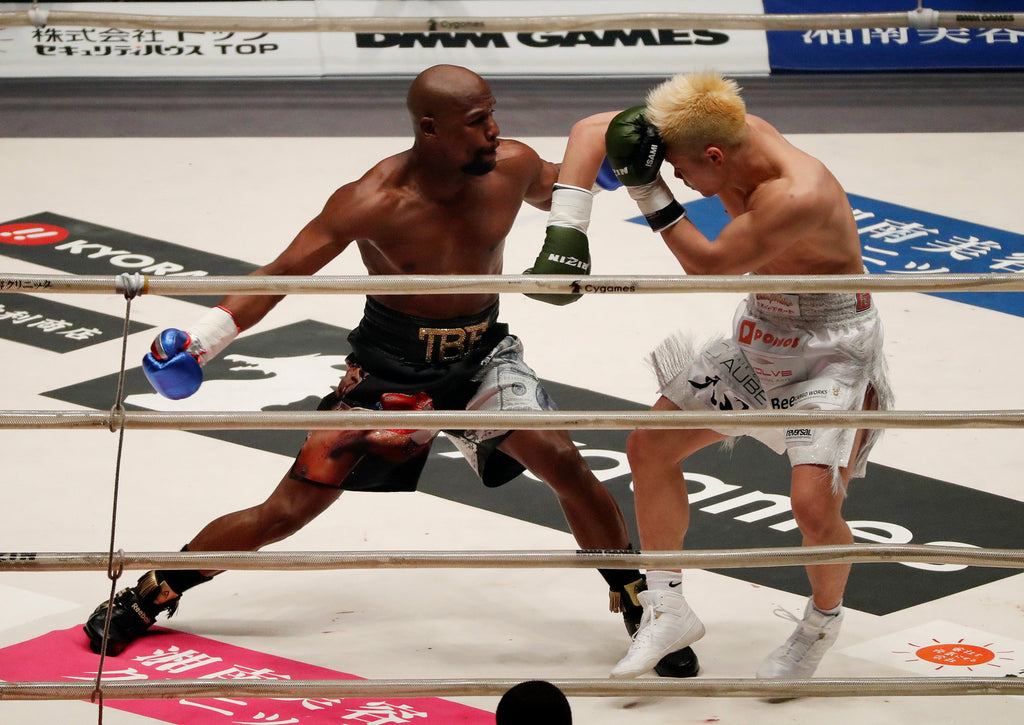Mayweather and Boxing's History of Exhibitions
Before Floyd Mayweather Jr. became a money-generating exhibition fighter, he was the best boxer of his generation.
Long before rallying to an unblemished 50-0 record with his all-time great defensive abilities as ‘Money’ Mayweather, he savagely tore through the lower divisions as ‘Pretty Boy’ Floyd.
Before that, Mayweather was the promising Olympic Bronze medallist driven to rise from his tough upbringing and push for ring greatness.
Every generation will see Mayweather differently. But currently, he’s the retired legend frequently adding to his wealth through high-profile exhibition fights.

After retiring properly following a one-sided beatdown of UFC star Conor McGregor in 2017, Mayweather continued his trend of low risk, high reward ring appearances against Tenshin Nasukawa, Logan Paul, Don Moore, Mikuru Asakur and, most recently, Deji Olatunji.
There’s a backlash each time Mayweather announces a new lucrative exhibition against another over-matched opponent.
But he’s not the first fighter to take this career step, with exhibition fights having been a vibrant part of boxing history from as far back as the late nineteenth century.
The History of Boxing Exhibitions
Many have been quick to label Mayweather’s ventures into the world of exhibition boxing as farcical, but the sport already holds a deep history of top names doing the same.
The key difference between exhibitions involving Mayweather and champions of the past is the amount of income being generated.
Mayweather is his own brand and any appearance in the ring, regardless of the underwhelming opponent hand-picked, will undoubtedly ensure him another sizeable pay day on foreign trips to the likes of Abu Dhabi and Japan.

Another difference is that boxers back in older times used to take part in exhibitions during their active careers, rather than when they had officially hung up their gloves properly.
Mayweather already conquered his era and retired undefeated, earning him the opportunity to invest his time into doing what he still loves at a low-risk, non-competitive level.
Before the ‘Money’ man, legends such as Jack Johnson, the first-ever black world heavyweight champion in history, and Jack Dempsey, an icon of the 'Roaring Twenties', were also known to participate in regular exhibitions.

Welsh legend Jimmy Wilde was another who moved into the life of exhibition fights in a bid to generate extra income alongside actual prize-fighting.
In the late 1800s, exhibitions were a typical occurrence in the sport, as big names of the time entered the ring for glorified sparring sessions across America and throughout parts of Europe.
John L. Sullivan, regarded as the first heavyweight champion of boxing’s gloved era, was involved in many travelling exhibition fights to draw in massive crowds and offer them a unique experience of entertainment.
Mayweather Leading The Exhibition Trend
Despite many jumping to criticise Mayweather as the antagonist for his exhibition exploits, arguably the most popular boxer in history, Muhammad Ali, memorably engaged in one of the most bizarre crossover clashes.
In 1976, while still an active fighter, Ali took to the ring in Tokyo, Japan against Antonio Inoki for what would become strange 15-round meeting.
Inoki spent the majority of the ‘fight’ on his back and kicked Ali’s legs that frequently that he was reportedly close to needing amputation from blood clots. ‘The Greatest’ was guaranteed six million dollars for his circus-like exhibition.

George Foreman, another all-time great heavyweight champion, once took part in a ‘Foreman vs. Five’ exhibition in 1975. After beating five separate professional opponents on the same night across three three-minute rounds, legendary announcer, Howard Cosell, dubbed the event “an utterly weird afternoon”.
The aforementioned Jack Dempsey took part in similar exhibition circumstances in 1931 but facing non-threatening foes in single two-minute round bouts, with their aim being to simply survive. If they did, they were allowed to attempt another round with the former heavyweight champion.
Back to modern day and heavyweight superstar Mike Tyson was another who has delved into exhibitions. His match-up, at 54 years old, with fellow legend Roy Jones Jr, then 51, in 2020 was contested over eight rounds live on pay-per-view.

Now 45 years old, Mayweather hasn’t been in a genuinely competitive fight for seven years but continues to step into the ring against lesser foes for prosperous financial rewards.
And why not? The cases in which boxers can retire on their own call with their full health intact and possessing enough financial stability are rare. Mayweather is an exception who now capitalises and leads the exhibition trend that was set well before him.
Header image: Cliff Hawkins/Getty Images
